

The City of Denver is hosting a modern architectural tour which lends enthusiasts their own
“key to the city”.
Vintage Homes of Denver would like to spread the word of this exciting opportunity to see the best in modern Denver real estate.

Modern Architecture: 50’s & Beyond
April 16-17
More than 70 sites in and around Denver
Mayor Bill Vidal, the Denver Office of Cultural Affairs and the Denver Architectural Foundation invite you to take an inside look at Denver’s distinctive buildings and unique places during Doors Open Denver 2011.
The theme of Doors Open Denver 2011, to be held April 16-17, is “Modern Architecture: 50’s & Beyond.” Doors Open Denver will feature sites that represent outstanding examples of this period.
This free weekend event invites citizens to experience Denver’s built environment in a new way - from the inside. Tour Denver’s architectural gems and lesser-known treasures on your own or participate in expert tours led by members of the architectural community.
DOORS OPEN DENVER 2011 SITE LIST
16th Street Mall
American Red Cross Mile High Chapter
American Woodmen Insurance/Humphries Poli Architects
Anchor Center for Blind Children
Ar7 Architects
Augustana Lutheran Church
Auraria Campus Commons – Tivoli Square
Auraria Campus: King Center
Auraria Campus: Library
Auraria Campus: Science Building
Babi Yar Park
Buell Theatre
Burns Park
Burnsley Hotel
Cable Center
Cell Museum
Colorado Convention Center
Commons Park
Crate & Barrel
Daniels Fund
Denver Art Museum – Hamilton Building
Denver Art Museum – Ponti Building
Denver Center Theater Company
Denver Health Medical Center: Rita Bass Trauma & EMS Education Institute
Denver Health Medical Center – Webb Building
Denver Museum of Nature & Science – West Addition
Denver Performing Arts Complex
Denver Police Traffic Operations & Firearms Training Facility
Denver Public Library Central Branch
Denver Public School of the Arts
Design Within Reach
District Three Police Station
DPAC Sculpture Garden
Ellie Caulkins Opera House
Gates Corporation
Hyatt Convention Center Hotel
INVESCO Field at Mile High
JW Marriott Cherry Creek
Kirkland Museum of Fine & Decorative Art
Lindsey-Flanigan Courthouse
Millennium Bridge
Mod Livin’
Museum of Contemporary Art Denver (MCA DENVER)
Olinger Funeral Home
Plus Gallery
RedLine Arts Center
Regis University - Adult Learning Center
Regis University - Coors Life Directions Center
Regis University - Field House
Regis University - Loyola Hall
Regis University - Pomponio Science Center
RNL
Room & Board
Ross-Cherry Creek Branch Library
Sheraton Downtown Denver Hotel
Speer Blvd Park
St John Francis Regis Chapel
Stapleton Central Park Recreation Center
Stapleton Central Parks & Open Space
Stapleton Fellowship Church
Stapleton Town Center
Tabor Center Lobby
TAXI I, TAXI II & Freight
Temple Emanuel
The Curtis
University of Denver - Cable Center
University of Denver - Daniels Business School
University of Denver - Olin Hall
University of Denver - Ritchie Center for Sports & Wellness
University of Denver - Robert & Judi Newman Center for the Performing Arts
US Environmental Protection Agency
Wastewater Management - City of Denver
Wellington E. Webb Municipal Office Building
William Havu Gallery & Courtyard
The fittest Americans call Denver home. Denver is consistently ranked on top ten lists throughout the United States as an active, healthy, weight conscience city. Walk through any Denver neighborhood, and amongst the stately Denver homes and well-groomed parks you will see a constant blur of human movement. There are joggers, walkers, bicyclists, skiers and even kayakers taking advantage of Denver‘s 300+ days of sunshine to hone their physiques and breathe in that crisp Rocky Mountain air.
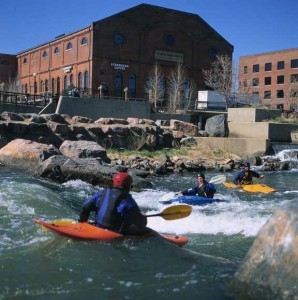
Kayakers on the Platte River in downtown Denver.
Take into account that these are only the outdoor exercise enthusiasts and you can imagine the number of Denver residents enjoying their home gyms, health clubs, yoga classes and pilates studios.
The desire for a more competitive outlet has manifested itself into rugby clubs, adult kickball teams, softball, soccer and other score oriented sports. It is easy to join teams and enjoy not only a day of sportsmanship, but a chance to meet new friends and have a pint after the match.
This healthy Denver culture that has also given rise to an impressive array of city-wide marathons. With the spring season just around the corner and the pressure of upcoming races, Denver runners are gearing up and training hard. These races are typically hosted by local charitable organizations as a fundraising tactic and come with little or no prize, other than the thrill of victory.
While there are runs and walks year-round, Denver‘s annual kick-off marathon is the Runnin’ of the Green on March 12, 2011. This 7k run/walk is in its 22nd year and benefits the Volunteers of America. In consideration of those not wanting to run, they also offer a wheelchair event and a 2-mile walk appropriately named the “Leprechaun Leap”.
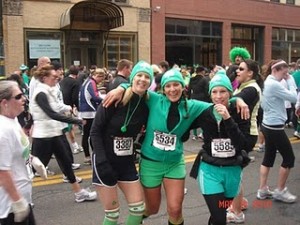
Denver's Runnin' of the Green
Boasting the best after party of any other Denver marathon, the Runnin’ of the Green has had to cap their event at 7,000 participants. With a nod to the Irish and St. Patrick’s Day, there will be Irish folk music, dancers and other Celtic goodies.
The urban course is set in the heart of Denver‘s LODO district with views of historic warehouses and factories that have been re-purposed to create exciting Denver real estate. Lofts, condos, restaurants and boutiques have all taken advantage of the industrial architecture and mountain views.
And so begins another Denver marathon season. There is a race or a walk in almost every Denver neighborhood each weekend. Several take place in Denver‘s most popular parks, such as Wash Park or City Park, but you can also find them on the along the Highline Canal, Platte River, Cherry Creek and Colfax Avenue.
The Tavern, a heralded Denver institution, has branched out into another up and coming Denver suburb. The newest installment by the Tavern Hospitality Group is under construction on Littleton‘s historic Main Street. The new eatery will join THG’s catalog of notable Denver bistros and bars, including several Taverns, the Soiled Dove and the Cowboy Lounge. A family-owned business that calls Denver home, THG has seen tremendous growth since opening the Soiled Dove in the LODO area of downtown Denver in 1997.
The popularity of the Taverns, which are located in Denver‘s top residential areas including Washington Park, Lowry, the Tech Center, Downtown and Uptown, is proven. Their newest venue in Littleton is highly anticipated by local residents. Each Tavern has taken into account the community in which they are located, but all incorporate a cozy atmosphere, fireplaces, patios, game rooms and an abundance of televisions for watching Denver‘s hometown heroes. Their diverse menu brings many pub favorites, as well as dishes offering Mexican and Asian influences.
The Taverns are consistently found on Denver‘s Top Ten Lists, including 5280 Magazine‘s “Top of the Town” and Westword‘s “Reader’s Choice Awards”. While each Tavern has received different accolades, each seems to be the place to meet after work, before the game, on a first date, or a casual night on the town.
The Tavern in Littleton is scheduled to open in the spring of 2011 at 2589 West Main Street. Working closely with the Historic Preservation board, the new restaurant will maintain the character of the neighborhood The 8,028 sq ft facility will seat 300 diners.
Though not resting on their laurels, owners Frank Schultz with Al and Terry Papay, are planning to open a Tavern in Congress Park later in the year. They may also be looking for new locations in the Highlands neighborhood in northwest Denver.
I went out yesterday with the intent to photograph the best examples of Denver real estate and the architectural styles represented. My list included Denver Squares, Craftsman bungalows, Victorians, Tudor Revival, Gothic Revival, Spanish Revival, Territorial style and any other homes that struck my fancy. Well, sounds like an easy task . . . but it wasn’t!
Denver is chock-full of some of the most beautiful homes! The eclectic mixture of homes is a visual timeline of the city’s development. With Victorians at the epicenter, built between 1870-1890, and rippling out to Denver Squares from the turn of the 20th century, Craftsman bungalows from the 1920's and 1930's, and modern homes making appearances in the suburbs in the 1950's, each Denver home style has left a trace of those who built them.
Like the rings of a tree, these Denver real estate patterns display changes in wealth, decorum, fashion, and the creation of city ordinances. While their particular styles may have blurred the textbook definition, they are undeniably wonderful. The Victorian mansions of Capitol Hill brought to mind the days of parasols and fine carriages.
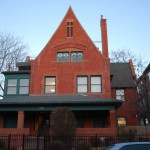
Peabody-Whitehead Mansion, Capitol Hill
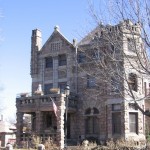
A Denver mansion in Capitol Hill.
The desire to fall into a daydream of historical significance was almost too much. After taking several shots and feeling as though I must take a picture of each one to completely convey the spirit of this magnificent Denver real estate, I forced myself to head east and see what other “painted ladies” awaited.
East of Capitol Hill is the Cheesman and Congress Park neighborhoods. These areas have large avenues (6th, 7th and 8th) complete with landscaped green ways between.
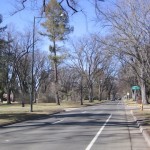
Congress Park 7th and 8th Avenues
The homes here are not Victorian, but rather a study in the Denver Square, Craftsman bungalow, Tudor Revival styles. While the most cavernous of these were on the avenues, smaller versions lined each street, north and south. Click, click, click! My starting, stopping, parking routine must have been quite mysterious to those around me. Certainly, I had taken enough shots and taken enough notes to feel that I had represented this lovely Denver neighborhood well. But, I still wanted to take more photos, they were all so picturesque.
Heading north, to find the big Victorians found me at City Park. The homes that line this most European park in Denver are magnificent. Luckily, this area is again a popular destination for folks looking to own an affordable historic home. Many of the forgotten mansions that were facing an untimely demise have been rescued. Victorians and Denver Squares hold the throne in this part of town.
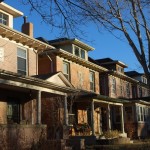
A row of Denver Squares in the City Park neighborhood.
On my way back south, I went through Hilltop and Park Hill. While Hilltop is a dominantly Tudor Revival area, the homes of Park Hill have a greater variety.
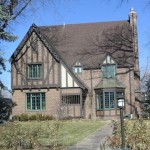
Park Hill Tudor
The Tudor Revival is next to a Spanish, which is next to a Gothic Revival, etc.
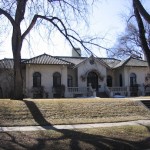
Spanish Revival in Park Hill
However, this mixture makes the area charming and extremely interesting to someone wanting to clearly see the differences in early 20th century architecture.
There are so many Denver homes that I find breathtaking. The necessity of whittling it down to just a few is overwhelming. Suffice to say that my day ended with two lifeless cameras. Time to change the batteries.
It is no secret that Denver has gone to the dogs. These four-legged (and three-legged on occasion) family members are reaping the benefits of a city that recognizes their place in our Denver homes. While every park can’t be an off-leash extravaganza, every walk should be special. Therefore, we at Vintage Homes of Denver have pinpointed 5 of our favorite doggy destinations within the metro Denver area.
1. Denver‘s most iconic park, City Park was the first official park within the city limits. Set aside by Governor Speers in 1893 for the purpose of a park grand enough to rival those in Europe, the 330-acres have not disappointed. The park is bordered by 17th Avenue to the south, York Street to the east, Colorado Boulevard to the west and 23rd Avenue to the north, with the City Park Golf Course found across 23rd Avenue.
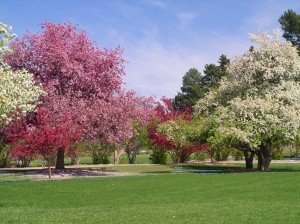
Spring comes to City Park.
The park is home to the Denver Museum of Nature and Science, the Denver Zoo, and greenhouses for the zoo and Denver Botanic Gardens. The grounds provide several walking trails, fountains, flower beds, a lake and duck pond. There are also horseshoe pits, baseball and soccer fields, handball courts and boat rentals.
The famous Pavilion is available for private events and is home to City Park Jazz concerts during the summer months. Several organizations take advantage of the park’s many attributes for marathons, walk-a-thons and other civic functions.
City Park has no off-leash area, but it is a fabulous destination to enjoy a satisfying jog with man’s best friend or a lazy stroll with a cup of coffee. The views of the Rocky Mountain front range are unparalleled and the Denver homes that circle the park are magnificent in their scale and style. The park has several hundred trees, all planted by schoolchildren in the early 20th century.
2. Perhaps the most popular of Denver‘s urban parks is Washington Park in the center of the Washington Park neighborhood. The 165-acre, well-groomed space is bordered by South Downing to the east, South Franklin to the west, East Louisiana to the south, and East Virginia to the north. The park is more than just a pleasant walk surrounded by some of the most beautiful Denver real estate available. Home to two lakes, gorgeous flower beds, two playgrounds and multiple walking paths, the heart of Wash Park offers many options for a stroll with Fido (or Dakota, Lady, Guinness and Stout).
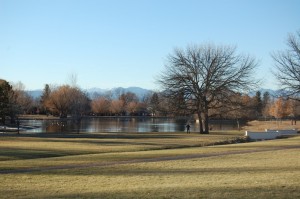
Autumn in Wash Park.
There is no off-leash area, officially, yet there are a number of dogs catching Frisbees at any given time. Several breed aficionados gather at the park including the Wash Park Weenies, a group of enthusiastic Dachshund owners.
The annual Furry Scurry is held in the park every May. The popular dog walk-a-thon raises funds for the Dumb Friends League, a popular animal shelter in Denver. Wash Park also has location as a key factor in its high ranking among dog lovers. The park is at the epicenter of the most sought after Denver real estate. Large Denver homes reflecting the architecture of the early 19th century give Wash Park a genteel air. The park is also close to the shops and coffee houses on Old South Gaylord and Pearl Street, enjoys easy access to the RTD light rail and is a short distance from most other parts of the city.
3. Chatfield State Parkis the best off-leash dog park in the city. Not some treeless patch of dirt surrounded by chain link fence, the dog park at Chatfield is a natural habitat for dogs to get back in touch with their inner dog self. The park has set aside 69-acres of Denver real estate for its canine citizens. Chatfield State Park is south of C-470 on Wadsworth Boulevard. It may be a bit of a drive from your Denver home, but will be well worth the effort.
The best thing about this off-leash area is that it is for the dogs. No bicyclists are permitted in the dog area, no joggers, no camp goers . . . only dogs and their people. The leashes come off and dogs are permitted to sniff and run to their hearts content. There are two small watering holes in the park, as well as access to the South Platte River. Swim away, swim away, swim away all!

A Border Collie takes a dive.
In addition to the off-leash dog area, there are also two dog training areas. These areas are meant for the training of hunting and retrieving dogs and are accessible only with a special permit.
The park requires a $7 per day entrance fee. However, there is much more to do and see than just the dog park. Enjoy a picnic lunch, hook a trout or even camp once your pooch has petered out. If you are strictly interested in the dog area, then you will be glad to hear that this spring a new entrance and smaller $2 fee is to be implemented for off-leash area access only. For more information on upcoming changes to this popular destination, see the full Denver Post story.
4. Harvard Gulch Park on the southern edge of Denver near Englewood, CO is bordered by South Logan Street to the west, East Iliff Avenue to the north, East Harvard Avenue to the south and South Ogden Street to the east. This large 57-acre section of Denver real estate was once the location of the State Home for Dependent and Neglected Children. The orphanage closed its doors in 1971, and though many of the institution’s building were torn down, a few remain. The land surrounding the State Home was also used as a community garden during the depression.
Today, Harvard Park includes a golf course, community garden, recreation center, swimming pool, playground and a series of walking paths. It has a wonderful view of the Rocky Mountains and offers a peaceful oasis for a stroll or jog with your furry friend.

Denver dog and owner enjoying a walk.
There is not an off-leash area in this park, but access to a branch of the “Smith Ditch” might make up for it. The CSU Extension office, which is located in the old toddler building from the orphanage days, is hoping to offer dog first aid classes.
There are plans to improve many of the park’s amenities, including the playground, performance area and flower maze. The Denver homes surrounding the park are mostly bungalows with a few scattered Victorians. The quaint cottages provide a nice backdrop for any activity within the park boundaries.
5. Okay, it’s not a park but the Highline Canal Trail is a fabulous way to get in an extra long walk or run with your Boston terrier or black lab. The Highline Canal was dug in 1883 to bring water from Waterton Canyon up through the farms of south Denver and eventually to the city itself. The trail system that runs along the canal is 66 miles long and has been designated as a National Landmark Trail. It offers a wide array of nature viewing opportunities, as well as a quiet respite from chaotic city life.
While sections of the trail are more heavily used than others, it is possible to often find yourself on a completely solitary excursion. The feeling of being on a country lane in the middle of a metropolitan area is simply wonderful. There can be a high volume of bicyclists and other walkers, so be sure to keep an ear out for the call of “on your left”.
The Highline Canal Trail cuts through some of the most valuable Denver real estate. The Denver homes and open spaces that you discover are not visible from streets or sidewalks. By using the trail, you are getting a backstage pass to some of the most exclusive and beautiful Denver homes.
The trail system is also used by many organizations as a location for fun runs and marathons. Several walking clubs and dog groups meet and walk the path.
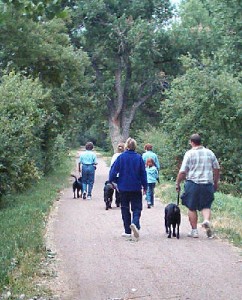
Guide dogs leash training on the Highline Canal Trail.
The Highline Canal Trail is not the only urban trail system in Denver. Being an active community, Denver has planned ahead and provided a maze-like system of paths, trails and walks for the citizenry. Denver Metro Trails has put together a comprehensive list of each trail system with maps.
While these are our personal favorites, Denver has a lot to offer dogs and their owners. Each Denver neighborhood has a selection of parks and paths that will prove delightful to man’s best friend. The City of Denver has put together a website that offers information on Denver parks, off-leash areas and laws regarding dog ownership.
And remember to bring your bags!
As you round the shores of Ketring Lake in Old Littleton, you may surprised to hear the enthusiastic bray of a nearby donkey, or the bleating of new lambs. Well, you have not stumbled into an eccentric’s backyard, but rather walked back in time.
The Littleton Museum, located at 6028 S. Gallup Street in Littleton, CO is a historic gem. Surrounded by quaint Littleton homes, this 39-acre portion of Littleton real estate has been put to good use for the benefit of all who call Littleton home. A repository for all things Littleton, the museum provides a glimpse into the past. The main building includes a research center that is open to the public for those who would like to know more about the city, their neighborhood, or even their home.
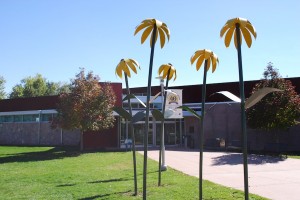
The Littleton Museum is celebrating its 40th year.
The artifact collection is home to 40,000 items that define Littleton‘s past. As you walk among the glass cabinets you can wonder at old photographs, clothing, machinery and personal memorabilia from Littleton‘s founding families. Toward the back of the museum building is the children’s area. This hands-on exploratorium has several exhibits that peak the interest of the youngest Littleton residents. Displays include a covered wagon, a 19th century kitchen playroom, a reading center, and newspaper workshop. There are also conference rooms and a well-stocked gift shop.
At the rear of the museum building you will pass through the doors and enter the farm portion. These doors represent a time portal where you can choose to enter the 1860's or 1890's.
To the right is the 1860's. This side of the farm has a log cabin, livestock, barn, pig sty, and Littleton‘s original one-room log schoolhouse. There are also volunteers and museum employees dressed in the garb of the era working the farm. We have been witness to fruit canning, bread baking, and sheep shearing. There is also a teacher in residence. These historical interpreters are experts on their time period and are excited to answer any questions from museum goers, no matter what age they may be.
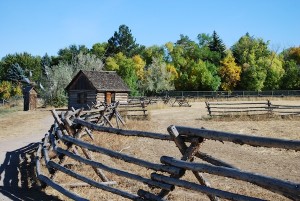
Littleton's original schoolhouse at the 1860's farm.
After you have toured the 1860s, you can follow the path to the 1890s farm. This farm is home to the relocated Bemis house. The Bemis’ were a prominent Littleton family whose son, Edwin, was once the editor of the Littleton newspaper.
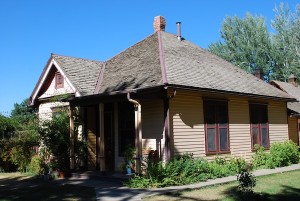
The Bemis home from the 1890's.
There is also a barn, windmill, chicken coop (complete with chicks), wagons and tool shed.
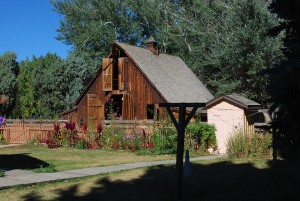
The 1890's barn at the Littleton Museum.
This homestead also has an active blacksmith shop. The blacksmith is on-hand to answer questions and will even take a custom order on occasion.
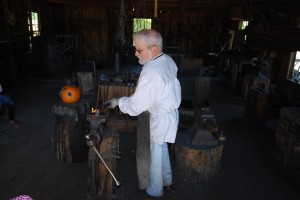
Resident blacksmith at the Littleton Museum.
The Littleton Museum is nestled in heart of Old Littleton. It is open Tuesday through Sunday all year. There are special events including the pumpkin patch in the fall and a Christmas celebration.
Admission to the Littleton Museum is free, however, donations are greatly appreciated.
Have you ever wanted to live in a haunted house? Well, now may be your chance. The Croke-Patterson-Campbell mansion is currently on the Denver real estate market and offers a glimpse into Denver‘s historic past, as well as the afterlife.
Built in 1893 for Thomas Croke, a successful experimental farmer, the mansion was an elaborate example of the rare Chateauesque style. Using local sandstone, the red castle looms large with parapets, turrets and stained glass windows. The home is a massive 12,000 square feet with four levels and an attached carriage house. Even among the other Victorian monoliths that populate the Capitol Hill neighborhood, the Croke-Patterson-Campbell mansion stands apart. Unfortunately, upon his first visit to his newly constructed home, Mr. Croke felt something just wasn’t right about the place and never returned. He sold the mansion in 1892 to the Patterson family.
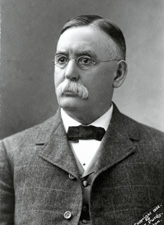
Thomas Patterson
The Patterson’s were a prominent Denver family, with both the senior Patterson and his son-in-law Richard Campbell serving in the state senate. The family was also longtime overseers of the Rocky Mountain News. Thomas Patterson lived with his daughter and her family until they sold the home in 1916.
The home saw many reincarnations throughout the 20th century. It has been utilized as a dance hall, a boarding house, apartment building, a radio station and an office complex.
The most notable haunting activity was documented during the renovations in the 1970s while creating the office spaces. Workers would return each day to find the work from the previous day undone. After many such events, the contractor purchased a pair of Doberman Pinschers to act as guard dogs. Sadly, one day the workers came to the mansion to find the two dogs dead on the sidewalk apparently after jumping from a third floor window.
Naturally, the ghostly activity did not halt with the completion of the offices. Office employees would hear equipment being used in empty rooms, feel sudden drafts from the basement, and often complain of loud partying from the top floor. Of course, there was no one residing on the top floor. After holding a seance, it was revealed that the spirit of a young girl haunted the castle. Supposedly, her body was entombed in the cellar. There was an excavation, and while a chamber was found, it was filled with sand.
Other specters are claimed to be present within the walls of the maze like Denver home. Reports of knocks, bangs, footsteps and an infant’s cry are the most commonly reported. There have also been several sightings of a gentleman in period garb walking between the home and the carriage house. This is believed to be the spirit of Thomas Patterson.
Dubbed as one of America’s most haunted mansions, the Croke-Patterson-Campbell mansion is certainly a fabulous visit to the past. Though it has been altered to accommodate each wave of residents, there has been care taken to preserve the unique attributes of the mansion. The fireplaces retain the original tile surrounds and mantles. The stained glass, though in need of some restoration, is strikingly beautiful and intact. The stately mahogany trim and paneling is unpainted as are the art niches. While the off-street parking is tight, the large carriage house could be restored allowing plenty of space for vehicles.
This piece of historic Denver real estate is available for $799,000.00. Though its current status is that of an office building, with a bit of elbow grease this stately home could be returned to a single-family residence.
For more information on this unique Denver home, or any other Denver real estate, please contact Jesse Sehlmeyer with Vintage Homes of Denver at 303-564-2245.
Extreme cold weather can be hard on both you and your home. Here are some tips to put into practice when freezing weather, snow, and ice hit your area.


Vintage Homes of Denver is proud to announce their listing at 6040 S. Bemis Street in Littleton. The home has been fully remodeled and is within walking distance to the best that Old Littleton has to offer.
If you would like to schedule a showing of this Denver home, or any other Denver real estate, place contact Vintage Homes of Denver at 303-564-2245.
<<<Previous Page | Next Page>>>
Â
Copyright © 2013 Vintage Homes of Denver
Real Estate Website Design by High Elevation